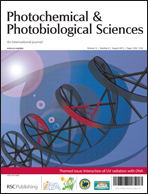Wavelength-dependent ultraviolet induction of cyclobutane pyrimidine dimers in the human cornea
Abstract
Exposition to ultraviolet (UV) light is involved in the initiation and the progression of skin cancer. The genotoxicity of UV light is mainly attributed to the induction of cyclobutane pyrimidine dimers (CPDs), the most abundant DNA damage generated by all UV types (UVA, B and C). The human cornea is also exposed to the harmful UV radiations, but no UV-related neoplasm has been reported in this ocular structure. The probability that a specific DNA damage leads to a mutation and eventually to cellular transformation is influenced by its formation frequency. To shed light on the genotoxic effect of sunlight in the human eye, we have analyzed CPD induction in the cornea and the iris following irradiation of ex vivo human eyes with UVA, B or C. The extent of CPD induction was used to establish the penetrance of the different UV types in the human cornea. We show that UVB- and UVC-induced CPDs are concentrated in the corneal epithelium and do not penetrate deeply beyond this corneal layer. On the other hand, UVA wavelengths penetrate deeper and induce CPDs in the entire cornea and in the first layers of the iris. Taken together, our results are undoubtedly an important step towards better understanding the consequences of UV exposure to the human eye.

- This article is part of the themed collection: Interaction of UV radiation with DNA

 Please wait while we load your content...
Please wait while we load your content...